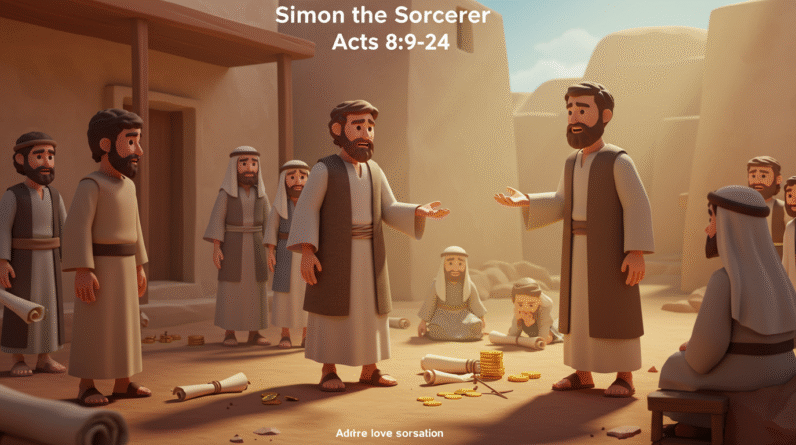“The Good Samaritan: A Bible Story” is an animated video created by Saddleback Kids, showcasing the parable of the Good Samaritan found in Luke 10:25-37. In this video, Jesus tells the story of a Jewish man who was attacked by bandits while traveling and left injured on the side of the road. The story unfolds as different individuals, including a priest and a Levite, pass by the injured man without offering any assistance. However, a Samaritan, a person despised by Jews, stops to help the injured man, showing compassion and kindness by tending to his wounds and taking him to an inn. The video concludes with Jesus stating that we should also show mercy to others, just like the Good Samaritan did.
This Bible story highlights the importance of showing love and compassion towards our neighbors, regardless of their background or circumstances. It teaches us to be aware of those who are in need and to extend a helping hand, following the example of the Good Samaritan. Through this story, Jesus aims to convey God’s heart and inspire us to live a life of mercy and kindness.
Overview
In this comprehensive article, we will explore the parable of the Good Samaritan from the Bible. This well-known story, told by Jesus in Luke 10:25-37, teaches us about the power of compassion and the true meaning of loving our neighbors as ourselves. We will delve into the context and setting of the parable, as well as examine the three main characters: the priest, the Levite, and the Samaritan. By understanding the lessons embedded in this story, we can apply its teachings to our own lives and strive to be Good Samaritans in our interactions with others.
Introduction to the Good Samaritan
The parable of the Good Samaritan is a poignant and timeless tale that has been passed down through generations. It presents a powerful message of compassion, challenging us to examine our own attitudes and actions towards those in need. This story is often used as a moral lesson, emphasizing the importance of showing kindness and mercy to others, regardless of their background or circumstances. By examining the Good Samaritan’s actions, we can learn valuable lessons about how to be a loving neighbor and make a positive impact on those around us.
The Parable of the Good Samaritan
The parable of the Good Samaritan is found in the Gospel of Luke, chapter 10, verses 25-37. It begins with a religious expert testing Jesus by asking him what he must do to inherit eternal life. Jesus responds by asking the expert what the law says, and the expert answers correctly, stating that one must love the Lord with all their heart, soul, strength, and mind, and love their neighbor as themselves. The expert then poses the question, “And who is my neighbor?”
In response, Jesus tells the parable of the Good Samaritan. He shares the story of a Jewish man who was traveling from Jerusalem to Jericho and was attacked by bandits. The man is left injured and half-dead on the roadside. As fate would have it, a priest passes by first but chooses to ignore the wounded man and continue on his way. Shortly after, a Levite, who also works in the temple, comes across the man but chooses to do the same. Finally, a Samaritan, who would have been despised by Jews at the time, comes across the wounded man and shows him compassion. The Samaritan tends to his wounds, takes him to an inn, and pays for his care.
Jesus then asks the religious expert which of the three men was a neighbor to the injured man. The expert answers, “The one who showed him mercy.” Jesus concludes by telling the expert to go and do likewise, urging him to be a neighbor to those in need just as the Samaritan was.
Context of the Parable
To fully grasp the significance of the parable of the Good Samaritan, it is essential to understand its context within the larger story of Jesus’ ministry. Jesus often used parables to convey deep spiritual truths and challenge societal norms. The parable of the Good Samaritan was no exception. It was told in response to a religious expert who sought to test Jesus’ knowledge and understanding of the law. The message of the parable serves as a reminder that true followers of God should embody compassion and mercy in their interactions with others.
Setting of the Parable
The setting of the parable takes place on the road from Jerusalem to Jericho. This particular route was known for its rough terrain and dangerous conditions, making it a prime location for bandit attacks. By choosing this setting for the parable, Jesus emphasizes the vulnerability of the injured man and the immediate need for help. The treacherous nature of the road serves as a backdrop for the contrasting responses of the priest, the Levite, and the Samaritan.
Characters in the Parable
The parable of the Good Samaritan features three main characters: the priest, the Levite, and the Samaritan. Each character represents a different response to the injured man and provides valuable insights into human behavior and attitudes towards those in need.
The Priest
The priest, who is a religious figure, passes by the injured man on the roadside and chooses not to help him. This character showcases the potential conflict between religious duty and compassionate action. The priest’s decision to ignore the wounded man highlights the danger of prioritizing ritual and rules over acts of love and mercy. Jesus’ inclusion of the priest in the story challenges religious leaders and believers to evaluate their own priorities and actions.
The Levite
The Levite, similar to the priest, also comes across the injured man but chooses to pass by without offering assistance. As someone who worked in the temple, the Levite represents another group with religious authority who fails to show compassion. While the Levite’s reasons for not helping are not explicitly stated, his actions reinforce the importance of not only professing religious beliefs but also actively living them out in practical ways.
The Samaritan
The Samaritan, in contrast to the priest and the Levite, stops to help the injured man. Samaritans were despised by Jews at the time due to historical and religious differences. By choosing a Samaritan as the hero of the story, Jesus challenges societal prejudices and shows that true love and compassion extend across all boundaries. The Samaritan’s actions of tending to the wounded man, taking him to an inn, and paying for his care exemplify the qualities of a Good Samaritan and provide a model for all believers to follow.
Conclusion
The parable of the Good Samaritan serves as a powerful reminder of the importance of compassion, mercy, and love in our interactions with others. Through the contrasting responses of the priest, the Levite, and the Samaritan, we are challenged to examine our own attitudes and actions towards those in need. This timeless story encourages us to transcend societal barriers and prejudices to be Good Samaritans in our own communities. By showing kindness and mercy to others, we can embody the teachings of Jesus and make a positive impact on the lives of those around us. Let us strive to go and do likewise, just as Jesus instructed.








